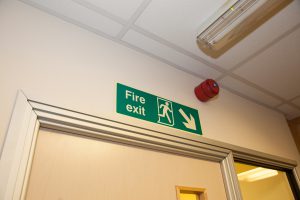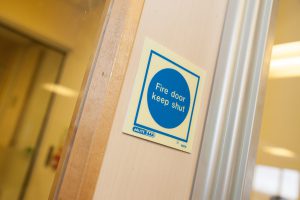Fire Escape Doors – Everything you need to Know
 As a vital part of your building’s ‘passive fire resistance’ – a blanket term for fire safety equipment that is designed to stop fires from spreading – fire doors not only provide a means of evacuation, they also prevent smoke and flames from reaching other areas within the premises. Ensuring that your property is sufficiently equipped with fire resistant doors is vital, as is keeping them maintained so they may operate at the optimum level.
As a vital part of your building’s ‘passive fire resistance’ – a blanket term for fire safety equipment that is designed to stop fires from spreading – fire doors not only provide a means of evacuation, they also prevent smoke and flames from reaching other areas within the premises. Ensuring that your property is sufficiently equipped with fire resistant doors is vital, as is keeping them maintained so they may operate at the optimum level.
A variety of regulations control the design and installation of fire doors, and units can be manufactured from a number of different materials, providing they are up to code. By design, fire doors are kept closed at all times, with automatic closing devices added, and propping them open is generally in violation of fire safety regulations.
Fire Door Regulations
Depending on whether an internal or external fire door is being installed within a new commercial building or an existing one determines which regulations must be adhered to. For new properties, a combination of relevant building regulations and the Regulatory Reform (Fire Safety) Order 2005 apply, while for existing buildings it is just the latter, brought in to replace the numerous and disparate fire safety laws in existence prior to this point.
- Regulatory Reform (Fire Safety) Order, 2005
A comprehensive piece of legislation, the Regulatory Reform (Fire Safety) Order combines every element of fire safety in commercial environments into one place. The reform covers all facets, including the fire safety duties of employers and responsible persons, how the regulations are enforced, the appeal process and more.
In relation to fire doors, the Regulatory Reform emphasises the importance of keeping all fire safety equipment well maintained and inspected regularly by a professional. It also states that only components that meet certified standards may be used in fire doors.
- Building Regulations
For those doors being fitted in brand-new properties, building regulations must be met. Those that apply to doors include Approved Document E (resistance to sound), Approved Document F (ventilation), Approved Document L (conservation of fuel and power), Approved Document M (access to and use of buildings) and Approved Document N (glazing safety).
However, when it comes to fire safety, the main regulations are detailed in Approved Document B (fire safety), 2006. The guidelines govern a number of requisite criteria that must be met. These include where fire doors should be fitted, the length of the fire resistance period that each door should provide, where fire door signage should be placed, where smoke seals are needed and more.
British Standards Institution
 Help exists for organisations that are attempting to comply with the various regulations that govern their fire safety. The British Standards Institution (BSI) is ideal in this scenario, providing a range of accreditations and standards for companies to adhere to. The one most closely related to fire safety is the BS OHSAS 19001, which covers all areas of Occupational Health and Safety Management.
Help exists for organisations that are attempting to comply with the various regulations that govern their fire safety. The British Standards Institution (BSI) is ideal in this scenario, providing a range of accreditations and standards for companies to adhere to. The one most closely related to fire safety is the BS OHSAS 19001, which covers all areas of Occupational Health and Safety Management.
This includes every aspect of health and safety in a commercial environment, from accident reduction to hazard identification, and applies to the necessary fire safety assessments which must be carried out at these locations.
Design
The regulations surrounding fire doors apply not just to the door leaf itself, but also to the frame surrounding it, as this is considered part of the structure.
Fire doors can be made from a number of different materials, from aluminium to steel to glass sections, although timber (often oak) is often the most common.
- Seals
The purpose of the seal around the edge of the door frame is to remain inactive until a blaze breaks out, whereby it will expand with the heat to form an intumescent barrier around the sides of the door.
Some doors will be fitted with smoke-only seals that react without the need for an increase in temperature, preventing potentially deadly smoke ingress through fire doors.
A combination of the two is the best way to ensure maximum safety.
- Glazing
Many fire doors include glass elements – particularly if they lead to outside areas. These components must then be able to match the fire resistance level of the rest of the door. This is achieved by applying a fire resistant glaze, allowing the glass to withstand the temperatures experienced in a fire for over an hour.
Test Procedures
In order to certify that fire doors and related components meet the levels required by law, they are put through rigorous testing to BS EN 1634-1:2014 standards. A revision of similar standards from 2000 and 2008, testing is carried out on all unit parts as a complete assembly, simultaneously trialling the door, doorframe, seals, locks, hinges, latches and more.
This will ensure that all component parts complement each other in their passive fire resistance capabilities.
Request a Callback
Just fill in your details below and we'll get back to you as soon as we can!

About Scutum London
Scutum London is a leading expert in fire safety and security solutions for businesses and organisations located across South East England, including London and Surrey.
From fire alarms, fire extinguishers and fire risk assessments to access control, CCTV and intruder alarm systems – and a lot more besides – we offer a comprehensive range of products and services designed to keep you, your business and your staff and visitors safe.
With decades of industry experience to call on, we’re proud to hold accreditations from leading trade associations and bodies such as British Approvals for Fire Equipment (BAFE), the British Fire Consortium, the Fire Industry Association (FIA) and Security Systems and Alarms Inspection Board (SSAIB).
If you’d like to find out more about Scutum London, get in touch with our friendly team or explore our products and services on our site.

